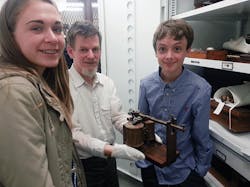This file type includes high resolution graphics and schematics when applicable.
3D printers are finding their way into schools around the world. Unfortunately, some schools may not know how to use 3D printers for education. Printing a chess piece might show that additive manufacturing is cool, but how can someone use a printer to communicate complex fundamentals of science to add value to the education process? Matthew Hoffman, an education specialist from the National Museum of American History, and a team of other educators are finding out.
The “American Innovations in an Age of Discovery” initiative is building invention kits that will serve as open-source tools for teachers and students to reinterpret and reinvent selected devices from history using modern manufacturing technology. The team starts by 3D scanning an original ground-breaking device, such as the telephone or electromagnetic engine, inventions from over a century ago. Then they make the scans available online, at 3d.si.edu/invention, along with files to print key components of the invention. The students do not just rebuild the past, but figure out how these components could be used in modern processes and devices that ultimately teach the fundamentals of STEM.
Having the ability for students to touch and interact with these kits gives them the opportunity to see that scientists are not just some eggheads in white lab coats that know everything. It lets them know that these inventors were normal people. They didn’t know everything when they started on the projects that led to invention, but understood the fundamentals and built from there. This is an exciting project that is directly teaching students how to stand on the shoulders of giants to ultimately inspire and inform a new generation of designers.
Getting students hands-on science experiences is making a great impact in student’s lives. Ask anyone that has gone through the FIRST Robotics Competition and you can see the passion young minds have to create and build. Unfortunately, when a piece of equipment such as a 3D printer is donated to a school, it might not get the support or budget for materials needed and they often get left in a closet. It is important to provide educators with both the equipment and the support to keep that equipment in use as learning tools.
By introducing young minds to old inventors and the inventions that built America, educators might bring forth a new generation of great scientists and engineers. For more information about the project, please contact Matt Hoffman at [email protected].



